ECO mode TESLA MODEL S 2014 Quick Guide (Europe)
[x] Cancel search | Manufacturer: TESLA, Model Year: 2014, Model line: MODEL S, Model: TESLA MODEL S 2014Pages: 52, PDF Size: 2.24 MB
Page 25 of 52
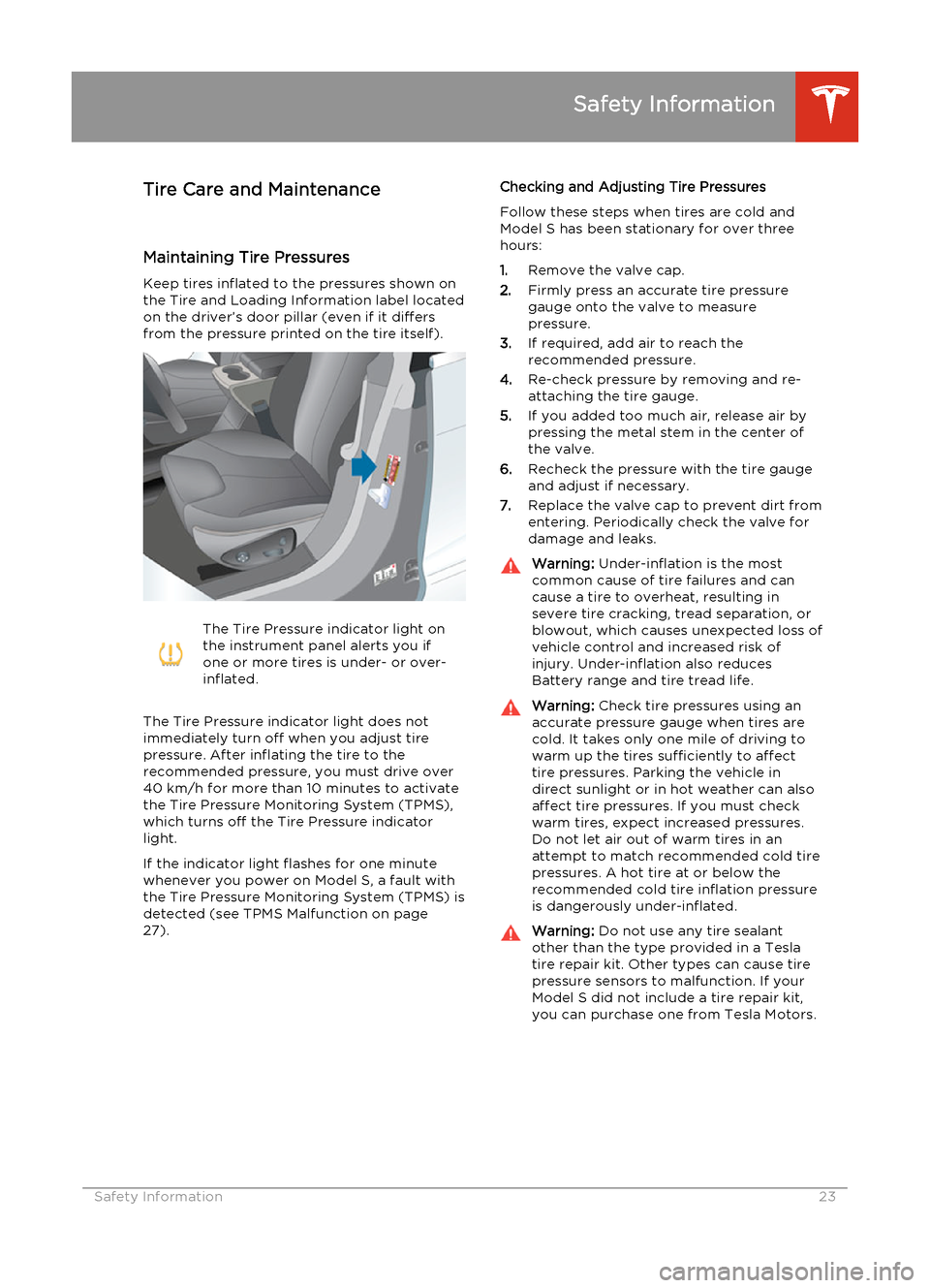
Tire Care and Maintenance
Maintaining Tire Pressures Keep tires inflated to the pressures shown on
the Tire and Loading Information label located on the driver’s door pillar (even if it differs
from the pressure printed on the tire itself).The Tire Pressure indicator light on
the instrument panel alerts you if
one or more tires is under- or over-
inflated.
The Tire Pressure indicator light does not
immediately turn off when you adjust tire
pressure. After inflating the tire to the
recommended pressure, you must drive over
40 km/h for more than 10 minutes to activate
the Tire Pressure Monitoring System (TPMS),
which turns off the Tire Pressure indicator
light.
If the indicator light flashes for one minute whenever you power on Model S, a fault with
the Tire Pressure Monitoring System (TPMS) is detected (see TPMS Malfunction on page
27).
Checking and Adjusting Tire Pressures
Follow these steps when tires are cold andModel S has been stationary for over three
hours:
1. Remove the valve cap.
2. Firmly press an accurate tire pressure
gauge onto the valve to measure
pressure.
3. If required, add air to reach the
recommended pressure.
4. Re-check pressure by removing and re-
attaching the tire gauge.
5. If you added too much air, release air by
pressing the metal stem in the center of
the valve.
6. Recheck the pressure with the tire gauge
and adjust if necessary.
7. Replace the valve cap to prevent dirt from
entering. Periodically check the valve for
damage and leaks.Warning: Under-inflation is the most
common cause of tire failures and can
cause a tire to overheat, resulting in
severe tire cracking, tread separation, or
blowout, which causes unexpected loss of vehicle control and increased risk ofinjury. Under-inflation also reduces
Battery range and tire tread life.Warning: Check tire pressures using an
accurate pressure gauge when tires are
cold. It takes only one mile of driving to
warm up the tires sufficiently to affect
tire pressures. Parking the vehicle in
direct sunlight or in hot weather can also affect tire pressures. If you must checkwarm tires, expect increased pressures.Do not let air out of warm tires in an
attempt to match recommended cold tire
pressures. A hot tire at or below the
recommended cold tire inflation pressure
is dangerously under-inflated.Warning: Do not use any tire sealant
other than the type provided in a Tesla tire repair kit. Other types can cause tire
pressure sensors to malfunction. If your Model S did not include a tire repair kit,
you can purchase one from Tesla Motors.
Safety Information
Safety Information23
Page 26 of 52
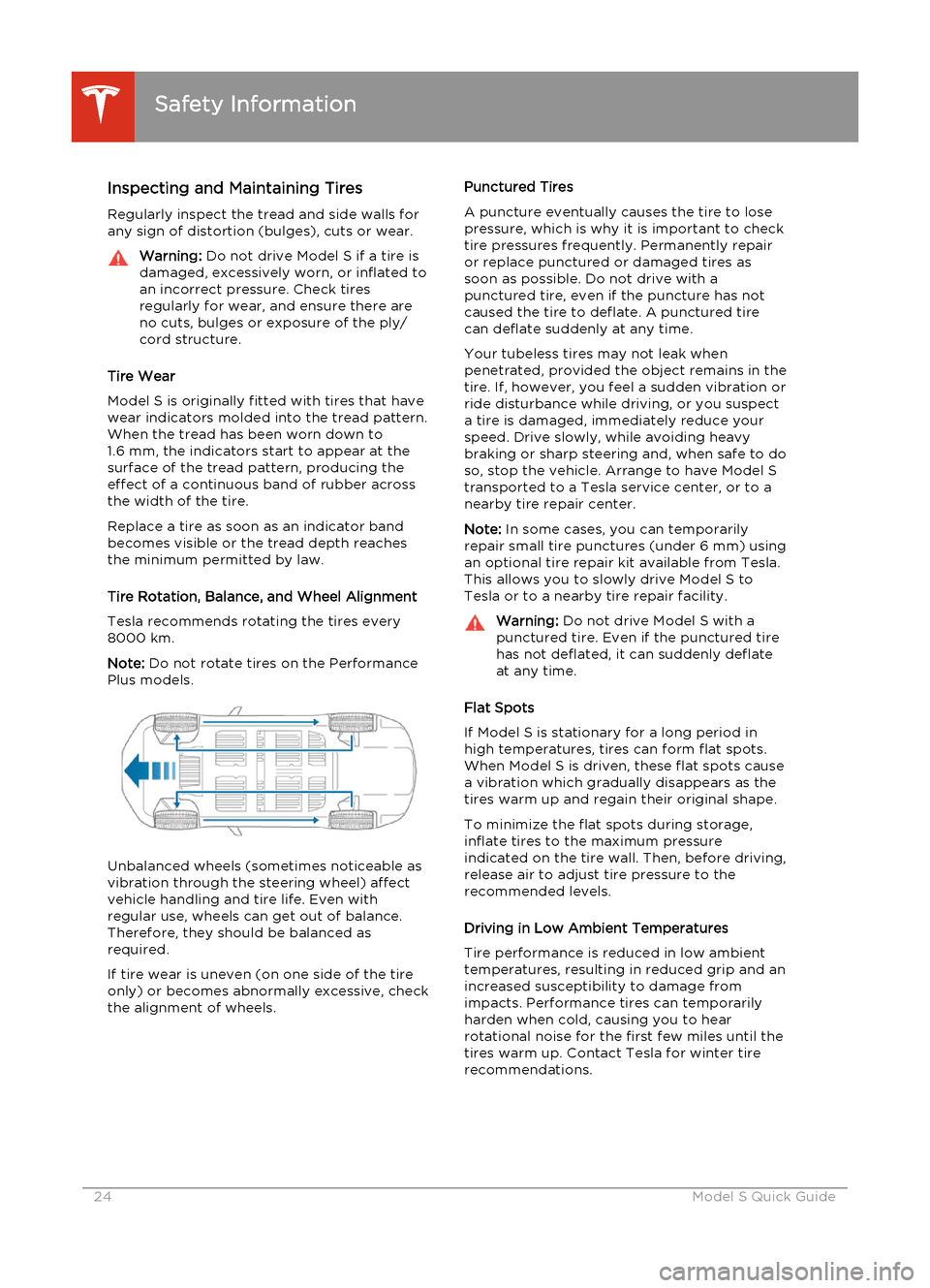
Inspecting and Maintaining TiresRegularly inspect the tread and side walls for
any sign of distortion (bulges), cuts or wear.Warning: Do not drive Model S if a tire is
damaged, excessively worn, or inflated to
an incorrect pressure. Check tires
regularly for wear, and ensure there are
no cuts, bulges or exposure of the ply/
cord structure.
Tire Wear
Model S is originally fitted with tires that have wear indicators molded into the tread pattern.
When the tread has been worn down to
1.6 mm, the indicators start to appear at the
surface of the tread pattern, producing the effect of a continuous band of rubber across
the width of the tire.
Replace a tire as soon as an indicator band
becomes visible or the tread depth reaches the minimum permitted by law.
Tire Rotation, Balance, and Wheel Alignment
Tesla recommends rotating the tires every 8000 km.
Note: Do not rotate tires on the Performance
Plus models.
Unbalanced wheels (sometimes noticeable as
vibration through the steering wheel) affect
vehicle handling and tire life. Even with
regular use, wheels can get out of balance. Therefore, they should be balanced as
required.
If tire wear is uneven (on one side of the tire
only) or becomes abnormally excessive, check
the alignment of wheels.
Punctured Tires
A puncture eventually causes the tire to lose
pressure, which is why it is important to check
tire pressures frequently. Permanently repair
or replace punctured or damaged tires as
soon as possible. Do not drive with a
punctured tire, even if the puncture has not
caused the tire to deflate. A punctured tire
can deflate suddenly at any time.
Your tubeless tires may not leak when
penetrated, provided the object remains in the
tire. If, however, you feel a sudden vibration or ride disturbance while driving, or you suspecta tire is damaged, immediately reduce your
speed. Drive slowly, while avoiding heavybraking or sharp steering and, when safe to do
so, stop the vehicle. Arrange to have Model S
transported to a Tesla service center, or to a
nearby tire repair center.
Note: In some cases, you can temporarily
repair small tire punctures (under 6 mm) using
an optional tire repair kit available from Tesla. This allows you to slowly drive Model S to
Tesla or to a nearby tire repair facility.Warning: Do not drive Model S with a
punctured tire. Even if the punctured tire has not deflated, it can suddenly deflate
at any time.
Flat Spots
If Model S is stationary for a long period in
high temperatures, tires can form flat spots. When Model S is driven, these flat spots causea vibration which gradually disappears as thetires warm up and regain their original shape.
To minimize the flat spots during storage,
inflate tires to the maximum pressure
indicated on the tire wall. Then, before driving, release air to adjust tire pressure to the
recommended levels.
Driving in Low Ambient Temperatures
Tire performance is reduced in low ambient temperatures, resulting in reduced grip and an
increased susceptibility to damage from
impacts. Performance tires can temporarily
harden when cold, causing you to hear
rotational noise for the first few miles until the tires warm up. Contact Tesla for winter tire
recommendations.
Safety Information
24Model S Quick Guide
Page 27 of 52
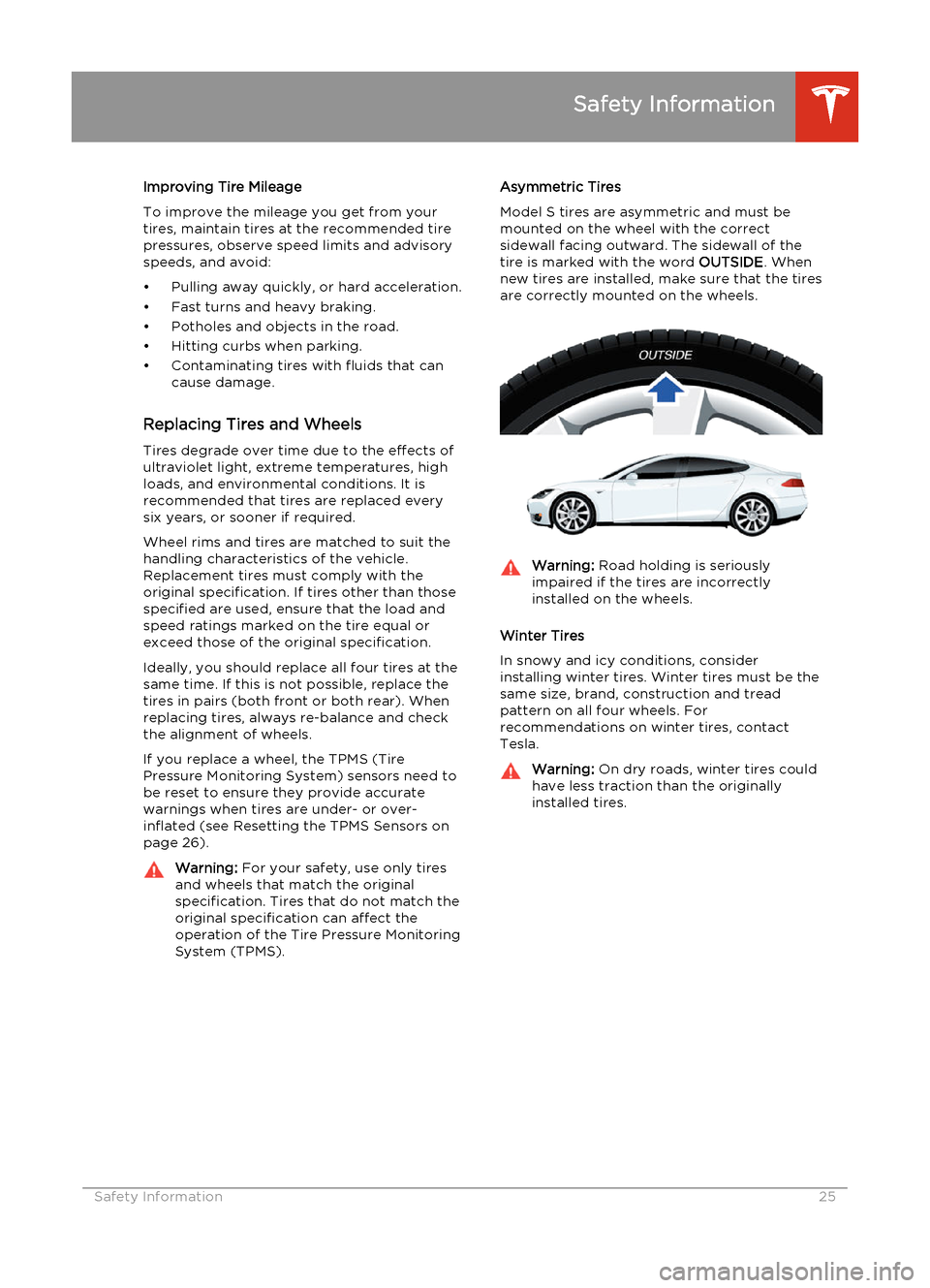
Improving Tire Mileage
To improve the mileage you get from your
tires, maintain tires at the recommended tire pressures, observe speed limits and advisory
speeds, and avoid:
• Pulling away quickly, or hard acceleration.
• Fast turns and heavy braking.
• Potholes and objects in the road.
• Hitting curbs when parking.
• Contaminating tires with fluids that can cause damage.
Replacing Tires and Wheels
Tires degrade over time due to the effects of
ultraviolet light, extreme temperatures, high loads, and environmental conditions. It is
recommended that tires are replaced every
six years, or sooner if required.
Wheel rims and tires are matched to suit the
handling characteristics of the vehicle.
Replacement tires must comply with the
original specification. If tires other than those
specified are used, ensure that the load and
speed ratings marked on the tire equal or
exceed those of the original specification.
Ideally, you should replace all four tires at the
same time. If this is not possible, replace the
tires in pairs (both front or both rear). When
replacing tires, always re-balance and check
the alignment of wheels.
If you replace a wheel, the TPMS (Tire
Pressure Monitoring System) sensors need to
be reset to ensure they provide accurate
warnings when tires are under- or over-
inflated (see Resetting the TPMS Sensors on
page 26).Warning: For your safety, use only tires
and wheels that match the original
specification. Tires that do not match the
original specification can affect the
operation of the Tire Pressure Monitoring System (TPMS).Asymmetric Tires
Model S tires are asymmetric and must be
mounted on the wheel with the correct sidewall facing outward. The sidewall of thetire is marked with the word OUTSIDE. When
new tires are installed, make sure that the tires
are correctly mounted on the wheels.Warning: Road holding is seriously
impaired if the tires are incorrectly
installed on the wheels.
Winter Tires
In snowy and icy conditions, consider installing winter tires. Winter tires must be the
same size, brand, construction and tread
pattern on all four wheels. For
recommendations on winter tires, contact Tesla.
Warning: On dry roads, winter tires could
have less traction than the originally
installed tires.
Safety Information
Safety Information25
Page 28 of 52
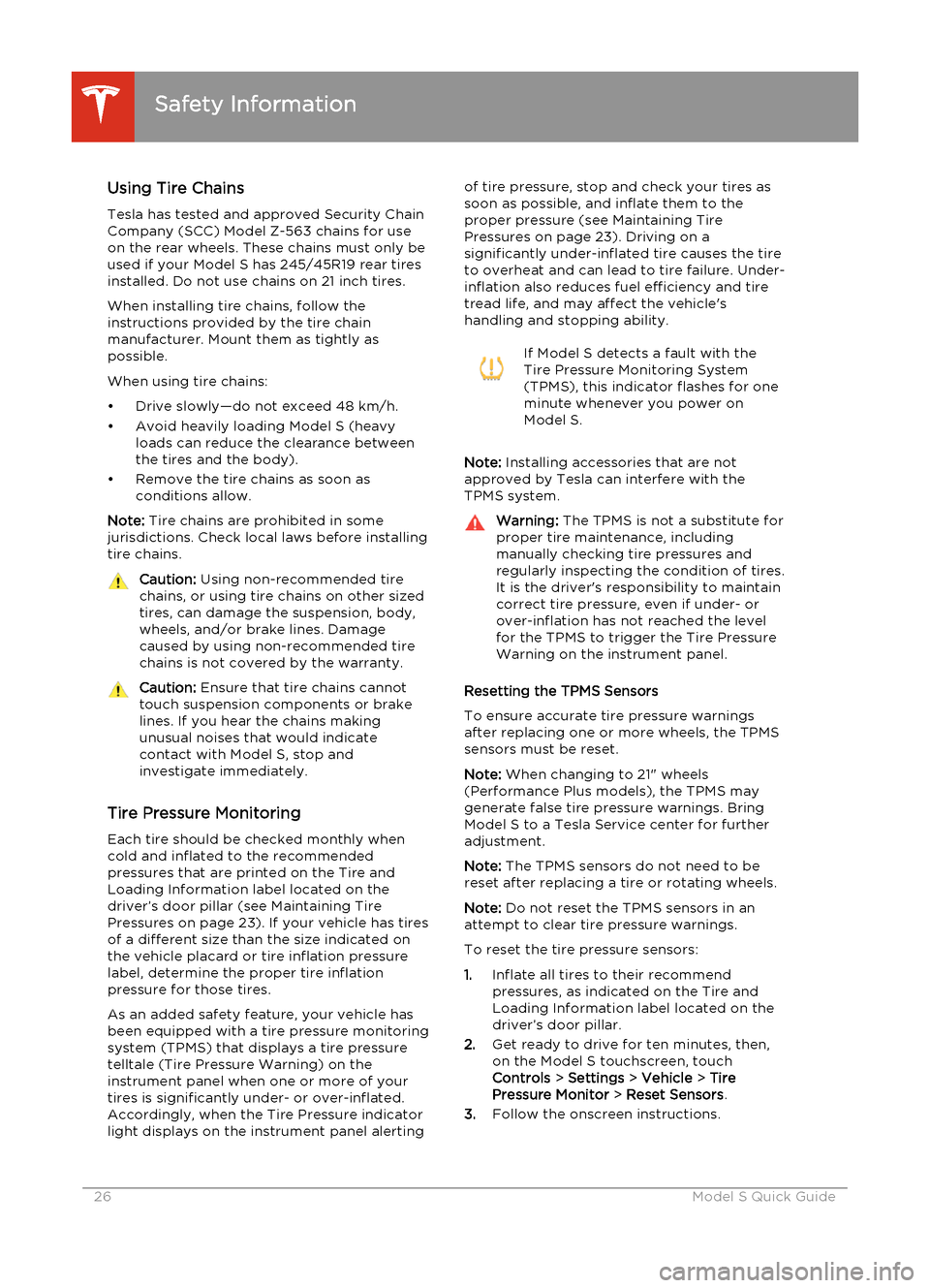
Using Tire ChainsTesla has tested and approved Security Chain
Company (SCC) Model Z-563 chains for use
on the rear wheels. These chains must only be
used if your Model S has 245/45R19 rear tires
installed. Do not use chains on 21 inch tires.
When installing tire chains, follow the
instructions provided by the tire chain
manufacturer. Mount them as tightly as
possible.
When using tire chains:
• Drive slowly—do not exceed 48 km/h.
• Avoid heavily loading Model S (heavy loads can reduce the clearance betweenthe tires and the body).
• Remove the tire chains as soon as conditions allow.
Note: Tire chains are prohibited in some
jurisdictions. Check local laws before installing
tire chains.Caution: Using non-recommended tire
chains, or using tire chains on other sized tires, can damage the suspension, body,wheels, and/or brake lines. Damagecaused by using non-recommended tire
chains is not covered by the warranty.Caution: Ensure that tire chains cannot
touch suspension components or brake
lines. If you hear the chains making
unusual noises that would indicate
contact with Model S, stop and
investigate immediately.
Tire Pressure Monitoring
Each tire should be checked monthly when
cold and inflated to the recommended
pressures that are printed on the Tire and
Loading Information label located on the
driver’s door pillar (see Maintaining Tire Pressures on page 23). If your vehicle has tires
of a different size than the size indicated on
the vehicle placard or tire inflation pressure
label, determine the proper tire inflation
pressure for those tires.
As an added safety feature, your vehicle has
been equipped with a tire pressure monitoring system (TPMS) that displays a tire pressuretelltale (Tire Pressure Warning) on the
instrument panel when one or more of your
tires is significantly under- or over-inflated.
Accordingly, when the Tire Pressure indicator
light displays on the instrument panel alerting
of tire pressure, stop and check your tires as
soon as possible, and inflate them to the proper pressure (see Maintaining TirePressures on page 23). Driving on a
significantly under-inflated tire causes the tire
to overheat and can lead to tire failure. Under-
inflation also reduces fuel efficiency and tire
tread life, and may affect the vehicle's
handling and stopping ability.If Model S detects a fault with the
Tire Pressure Monitoring System
(TPMS), this indicator flashes for one
minute whenever you power on
Model S.
Note: Installing accessories that are not
approved by Tesla can interfere with the TPMS system.
Warning: The TPMS is not a substitute for
proper tire maintenance, including
manually checking tire pressures and
regularly inspecting the condition of tires.
It is the driver's responsibility to maintain
correct tire pressure, even if under- or
over-inflation has not reached the level
for the TPMS to trigger the Tire Pressure Warning on the instrument panel.
Resetting the TPMS Sensors
To ensure accurate tire pressure warnings
after replacing one or more wheels, the TPMS sensors must be reset.
Note: When changing to 21" wheels
(Performance Plus models), the TPMS may
generate false tire pressure warnings. Bring Model S to a Tesla Service center for furtheradjustment.
Note: The TPMS sensors do not need to be
reset after replacing a tire or rotating wheels.
Note: Do not reset the TPMS sensors in an
attempt to clear tire pressure warnings.
To reset the tire pressure sensors:
1. Inflate all tires to their recommend
pressures, as indicated on the Tire and Loading Information label located on the
driver’s door pillar.
2. Get ready to drive for ten minutes, then,
on the Model S touchscreen, touch
Controls > Settings > Vehicle > Tire
Pressure Monitor > Reset Sensors .
3. Follow the onscreen instructions.
Safety Information
26Model S Quick Guide
Page 32 of 52
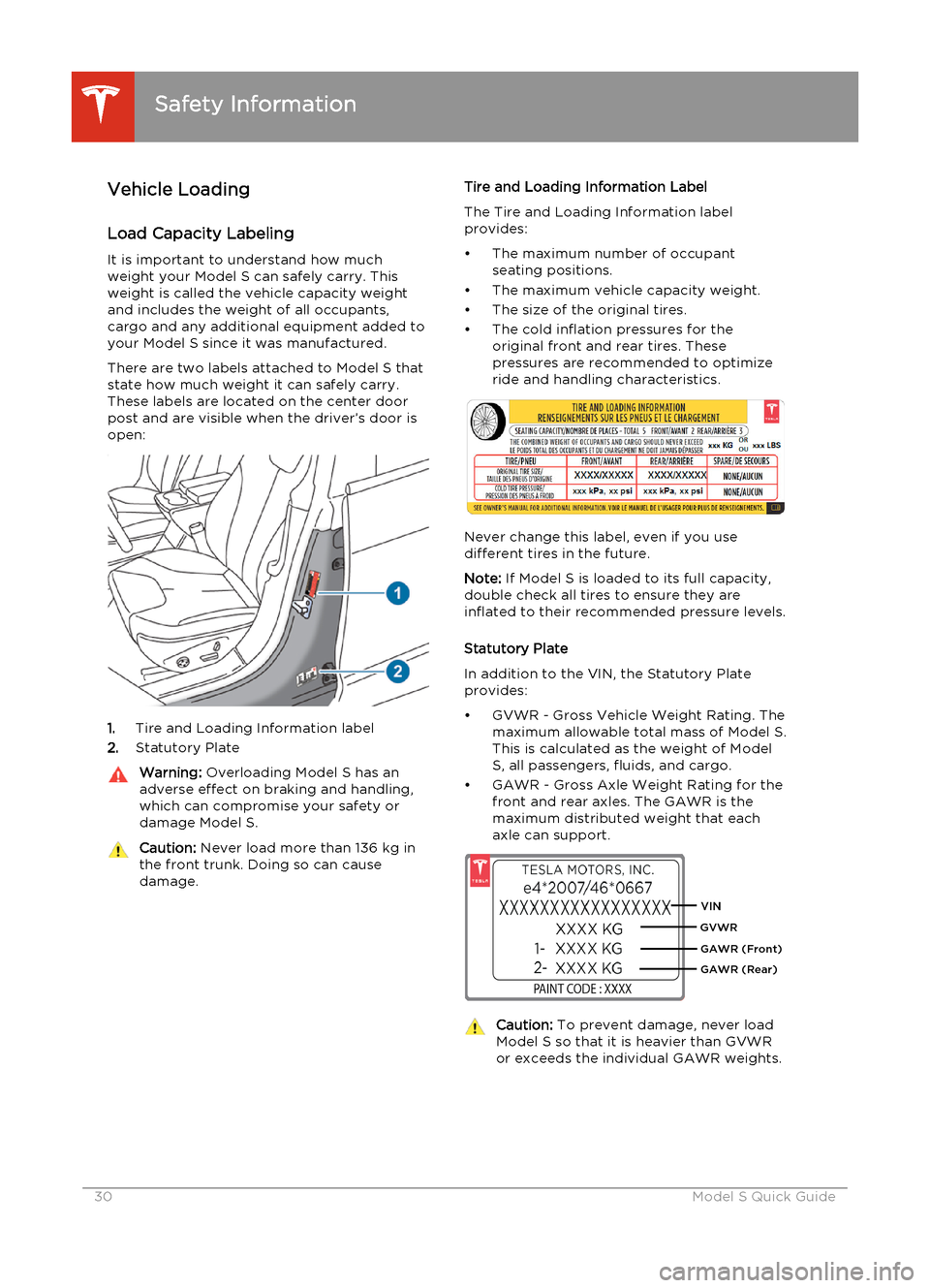
Vehicle Loading
Load Capacity Labeling It is important to understand how much
weight your Model S can safely carry. This weight is called the vehicle capacity weight
and includes the weight of all occupants, cargo and any additional equipment added toyour Model S since it was manufactured.
There are two labels attached to Model S that
state how much weight it can safely carry.
These labels are located on the center door
post and are visible when the driver’s door is
open:
1. Tire and Loading Information label
2. Statutory Plate
Warning:
Overloading Model S has an
adverse effect on braking and handling,
which can compromise your safety or
damage Model S.Caution: Never load more than 136 kg in
the front trunk. Doing so can cause
damage.Tire and Loading Information Label
The Tire and Loading Information labelprovides:
• The maximum number of occupant seating positions.
• The maximum vehicle capacity weight.
• The size of the original tires.
• The cold inflation pressures for the original front and rear tires. These
pressures are recommended to optimize
ride and handling characteristics.
Never change this label, even if you use different tires in the future.
Note: If Model S is loaded to its full capacity,
double check all tires to ensure they are
inflated to their recommended pressure levels.
Statutory Plate
In addition to the VIN, the Statutory Plate provides:
• GVWR - Gross Vehicle Weight Rating. The maximum allowable total mass of Model S.
This is calculated as the weight of Model
S, all passengers, fluids, and cargo.
• GAWR - Gross Axle Weight Rating for the front and rear axles. The GAWR is the
maximum distributed weight that each
axle can support.
Caution: To prevent damage, never load
Model S so that it is heavier than GVWR
or exceeds the individual GAWR weights.
Safety Information
30Model S Quick Guide
Page 33 of 52

Calculating Load Limits
1. Locate the statement “The combined
weight of occupants and cargo should never exceed XXX kg or XXX lbs” on your
vehicle’s “Tire and Loading Information” label.
2. Determine the combined weight of the
driver and passengers that will be riding in
the vehicle.
3. Subtract the combined weight of the
driver and passengers from XXX kg (see
Step 1).
4. The resulting figure equals the available
amount of cargo and luggage load
capacity. For example, if the “XXX”
amount equals 635 kg, and there will be five 68 kg passengers in the vehicle, the
amount of available cargo and luggage capacity is 295 kg (635 ‑ 340
(5 x 68) = 295 kg).
5. Determine the combined weight of cargo
and luggage being loaded on the vehicle.
That weight must not exceed the available
cargo and luggage load capacity
calculated in Step 4.Warning: The front and rear trunks are
the preferred places to carry objects. In
an accident, or during hard braking and sharp turns, loose items in the cabin
could injure occupants.
Example Load Limit Calculations
How much cargo you can carry in Model S
depends on the number and weight of
passengers. The following are typical
examples of calculated load limits. These
examples assume passengers weighing 68 kg. If the passengers weigh more or less, the
available cargo and luggage load capacity decreases or increases respectively.
Example 1: Driver and one passenger
DescriptionTotalVehicle capacity weight433 kgSubtract occupant weight (2 x 68
kg)136 kgAvailable cargo weight297 kgExample 2: Driver and four passengersDescriptionTotalVehicle capacity weight433 kgSubtract occupant weight (5 x 68
kg)340 kgAvailable cargo weight93 kg
The available cargo or luggage weight should
then be distributed between the front and
rear trunks.
Caution: Do not exceed the maximum
front trunk load weight of 136 kg.
Towing a Trailer
Warning: Do not tow a trailer. Model S
does not support a trailer hitch. Installing one could damage Model S and increase
the risk of an accident.
Disclaimers
Vehicle Telematics/Data Recorders
This vehicle is equipped with electronic
modules that monitor and record data from
various vehicle systems, including the motor,
Battery, braking and electrical systems. The
electronic modules record information about
various driving and vehicle conditions,
including braking, acceleration, trip and other related information regarding your vehicle.
These modules also record information about
the vehicle’s features such as charging events
and status, the enabling/disabling of various
systems, diagnostic trouble codes, VIN, speed,
direction and location.
The data is stored by the vehicle and may be
accessed, used and stored by Tesla service
technicians during vehicle servicing or
periodically transmitted to Tesla wirelessly
through the vehicle’s telematics system. This data may be used by Tesla for various
purposes, including, but not limited to:
providing you with Tesla telematics services; troubleshooting; evaluation of your vehicle’s
quality, functionality and performance;
analysis and research by Tesla and its partners
for the improvement and design of our
vehicles and systems; and as otherwise may be required by law. In servicing your vehicle,
Safety Information
Safety Information31
Page 34 of 52

we can potentially resolve issues remotely
simply by reviewing your vehicle’s data log.
Tesla’s telematics system wirelessly transmits vehicle information to Tesla on a periodic
basis. The data is used as described above and helps ensure the proper maintenance of
your vehicle. Additional Model S features may use your vehicle’s telematics system and theinformation provided, including features suchas charging reminders, software updates, and
remote access to, and control of, various
systems of your vehicle.
Tesla does not disclose the data recorded in
your vehicle to any third party except when:
• An agreement or consent from the vehicle’s owner (or the leasing companyfor a leased vehicle) is obtained.
• Officially requested by the police or other authorities.
• Used as a defense for Tesla in a lawsuit. • Ordered by a court of law.
• Used for research purposes without disclosing details of the vehicle owner or
identification information.
• Disclosed to a Tesla affiliated company, including their successors or assigns, or
our information systems and data
management providers.
In addition, Tesla does not disclose the data
recorded to an owner unless it pertains to a
non-warranty repair service and in this case,
will disclose only the data that is related to the repair.
Quality Control You might notice a few km on the odometer
when you take delivery of your Model S. This is a result of a comprehensive testing process
that ensures the quality of your Model S.
The testing process includes extensive
inspections during and after production. The final inspection takes place at Tesla Motors
and includes a road test conducted by a
technician.
Safety Information
32Model S Quick Guide
Page 36 of 52

General Warranty ProvisionsTesla Motors Netherlands B.V., Atlasstraat 7-9, 5047 RG Tilburg, Netherlands (“Tesla”) willprovide repairs to a Model S vehicle during the applicable warranty period in accordance with the
terms, conditions and limitations defined in this New Vehicle Limited Warranty.
You may also have other legal rights and remedies conveyed by your local laws (which may vary
by country) in addition to the rights and remedies provided to you under this New Vehicle
Limited Warranty.
For any additional provisions which relate to your territory, please see Country Specific Consumer
Disclosure on page 41.
Who is the Warrantor? Tesla Motors Netherlands B.V.
Atlasstraat 7-9, 5047 RG
Tilburg, Netherlands
Attention: Vehicle Service
Phone number: 0031 13 515 97 30
What Vehicles are Covered?
This New Vehicle Limited Warranty applies to a Model S vehicle sold by Tesla in the Tesla European Warranty Region. For the purposes of this New Vehicle Limited Warranty, the Tesla
European Warranty Region is defined as including the Member States of the European Economic
Area, Monaco, San Marino, and Switzerland, provided that you return to the applicable region or
country in which the vehicle was originally purchased from Tesla in order to receive warranty
service. For example, a customer purchasing a vehicle from Tesla in the European Economic Area must return to the European Economic Area in order to obtain warranty service, and customers
purchasing vehicles from Tesla in Monaco, San Marino, and Switzerland must return to the
respective country to obtain warranty service (e.g. a customer who purchased a vehicle fromTesla in Switzerland must return to Switzerland). Any subsequent purchaser or transferee mustreturn to the applicable region or country in which the vehicle was originally purchased fromTesla in order to obtain warranty service, regardless of the country in which such purchaser ortransferee may have purchased the vehicle.
Multiple Warranty Conditions
This New Vehicle Limited Warranty contains warranty terms and conditions that may vary
depending on the part or system covered. A warranty for specific parts or systems is governed by
the coverage set forth in that warranty section as well as other provisions in this New Vehicle
Limited Warranty.
Limitations and DisclaimersTHIS NEW VEHICLE LIMITED WARRANTY IS THE ONLY EXPRESS WARRANTY MADE INCONNECTION WITH YOUR TESLA VEHICLE. IMPLIED AND EXPRESS WARRANTIES AND CONDITIONS ARISING UNDER YOUR LOCAL LAW OR IN EQUITY, IF ANY, INCLUDING, BUT NOT
LIMITED TO, IMPLIED WARRANTIES AND CONDITIONS OF MERCHANTABILITY OR
MERCHANTABLE QUALITY, FITNESS FOR A PARTICULAR PURPOSE, DURABILITY, OR THOSE
ARISING BY A COURSE OF DEALING OR USAGE OF TRADE, ARE DISCLAIMED TO THE FULLEST
EXTENT ALLOWABLE BY YOUR LOCAL LAW, OR LIMITED IN DURATION TO THE TERM OF THIS
NEW VEHICLE LIMITED WARRANTY. SOME COUNTRIES DO NOT ALLOW LIMITATIONS ON
IMPLIED WARRANTIES OR CONDITIONS AND/OR HOW LONG AN IMPLIED WARRANTY OR CONDITION LASTS, SO THE ABOVE LIMITATIONS MAY NOT APPLY TO YOU.
Warranty
34Model S Quick Guide
Page 37 of 52

TO THE EXTENT PERMITTED BY YOUR LOCAL LAW, THE PERFORMANCE OF NECESSARYREPAIRS AND REPLACEMENT OF NEW OR REMANUFACTURED PARTS BY TESLA FOR THECOVERED DEFECTS IS THE EXCLUSIVE REMEDY UNDER THIS NEW VEHICLE LIMITEDWARRANTY OR ANY IMPLIED WARRANTIES.
Tesla does not authorize any person or entity to create for it any other obligations or liability in
connection with this New Vehicle Limited Warranty.
The decision of whether to repair or replace a part or to use a new or remanufactured part under
this New Vehicle Limited Warranty will be made by Tesla, in its sole discretion.
Your Rights Under Local Law This New Vehicle Limited Warranty gives you specific legal rights. These rights do not substitute
for or affect your statutory rights under your local law. In addition to the rights arising under this
New Vehicle Limited Warranty, you may have additional rights arising from your local law
including, but not limited to, any statutory warranty rights.
Ownership Transfer This New Vehicle Limited Warranty is transferable at no cost to any person(s) who subsequently
and lawfully assume(s) ownership of the vehicle after the first retail purchaser within the described limitations of this New Vehicle Limited Warranty (“subsequent owner”). To themaximum extent permitted by the local laws applicable to any subsequent owner, no statutorywarranty or similar rights to which the first retail purchaser of the vehicle may have been entitled
will be transferred to any subsequent owner.
Who Can Enforce this New Vehicle Limited Warranty? The first retail purchaser, or subsequent owner, of a new Model S vehicle sold in the Tesla
European Warranty Region, titled or registered in the name of the first retail purchaser, or
subsequent owner, according to your local law, can enforce this New Vehicle Limited Warranty,
subject to the terms of this New Vehicle Limited Warranty.
When Does the Warranty Period Begin and End?
This New Vehicle Limited Warranty begins on the first day a new vehicle is put into use by delivery to the first retail purchaser(s), or by leasing or registering as a company car ordemonstrator, whichever is earlier, and provides coverage for the period based on the specified
warranty as described in the section Warranty Coverage on page 35. Parts repaired or replaced, including replacement of the vehicle, under this New Vehicle Limited Warranty are covered only
until the applicable warranty period of this New Vehicle Limited Warranty ends, or as otherwise
provided by your local law.
Warranty Coverage
This New Vehicle Limited Warranty includes the Basic Vehicle Limited Warranty, the
Supplemental Restraint System (“SRS”) Limited Warranty, and the Battery Limited Warranty,
each as described below. Subject to the exclusions and limitations described in this New Vehicle Limited Warranty, such repair or parts replacement will be performed without cost to you by
Tesla when Tesla is notified of the covered defect within the applicable warranty period.
Repairs will be performed using new or remanufactured parts at the sole discretion of Tesla. All
replaced parts or other components are the exclusive property of Tesla unless otherwise provided
under your local law.
Warranty
Warranty35
Page 38 of 52

Basic Vehicle Limited Warranty
Subject to separate coverage for certain parts and the exclusions and limitations described in this New Vehicle Limited Warranty and any minimum period which may be required by your local law,
the Basic Vehicle Limited Warranty covers the repair or replacement necessary to correct defects in the materials or workmanship of any parts manufactured or supplied by Tesla that occur under
normal use for a period of 4 years or 80,000 km (50,000 miles), whichever comes first.
Supplemental Restraint System Limited Warranty
Subject to the exclusions and limitations described in this New Vehicle Limited Warranty and any minimum period which may be required by your local law, the SRS Limited Warranty covers the
repair or replacement necessary to correct defects in the materials or workmanship of the vehicle’s seat belts or air bag system manufactured or supplied by Tesla that occur under normal
use for a period of 5 years or 100,000 km (60,000 miles), whichever comes first.
Battery Limited Warranty
The Model S lithium-ion battery (the “Battery”) is an extremely sophisticated powertrain component designed to withstand extreme driving conditions. You can rest easy knowing thatTesla’s state-of-the-art Battery is backed by this Battery Limited Warranty, which covers therepair or replacement of any malfunctioning or defective Battery, subject to the limitationsdescribed below. If your Battery requires warranty service, Tesla will repair the unit, or replace it
with a factory reconditioned unit that has an energy capacity at least equal to that of the original
Battery before the failure occurred. To provide you with even more assurance, this Battery
Limited Warranty will also cover damage to your vehicle from a Battery fire even if it is the result
of driver error. (Coverage will not extend to damage that had already been sustained before a
Battery fire occurred, or to any damage if the Battery fire occurred after your vehicle had already been totaled.) Your vehicle’s Battery is covered under this Battery Limited Warranty for a period
of 8 years or for the number of km/miles specified below for your Battery configuration,
whichever comes first:
• 60 kWh - 200,000 km (125,000 miles) • 85 kWh - unlimited km/miles
Despite the breadth of this warranty, damage resulting from intentional actions (including intentionally abusing or destroying your vehicle or ignoring active vehicle warnings), a collision or
accident (excluding from Battery fires as specified above), or the servicing or opening of the
Battery by non-Tesla personnel, is not covered under this Battery Limited Warranty.
In addition, damage resulting from the following activities is not covered under this Battery
Limited Warranty:
• Exposing the vehicle to ambient temperatures above 60°C (140°F) or below -30°C (-22°F) for more than 24 hours at a time;
• Physically damaging the Battery, or intentionally attempting, either by physical means, programming, or other methods, to extend (other than as specified in your ownerdocumentation) or reduce the life of the Battery;
• Exposing the Battery to direct flame (excluding from Battery fires as specified above); or,
• Flooding of the Battery.
The Battery, like all lithium-ion batteries, will experience gradual energy or power loss with time
and use. Loss of Battery energy or power over time or due to or resulting from Battery usage, is
NOT covered under this Battery Limited Warranty. See your owner documentation for important
information on how to maximize the life and capacity of the Battery.
Warranty
36Model S Quick Guide